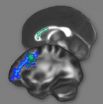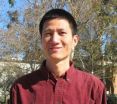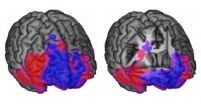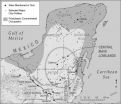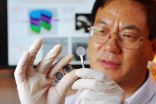(Press-News.org) ATLANTA – Scientists at Georgia State University have found that the ability to hear is lessened when, as a result of injury, a region of the brain responsible for processing sounds receives both visual and auditory inputs.
Yu-Ting Mao, a former graduate student under Sarah L. Pallas, professor of neuroscience, explored how the brain's ability to change, or neuroplasticity, affected the brain's ability to process sounds when both visual and auditory information is sent to the auditory thalamus.
The study was published in the Journal of Neuroscience.
The auditory thalamus is the region of the brain responsible for carrying sound information to the auditory cortex, where sound is processed in detail.
When a person or animal loses input from one of the senses, such as hearing, the region of the brain that processes that information does not become inactive, but instead gets rewired with input from other sensory systems.
In the case of this study, early brain injury resulted in visual inputs into the auditory thalamus, which altered how the auditory cortex processes sounds.
The cortical "map" for discriminating different sound frequencies was significantly disrupted, she explained.
"One of the possible reasons the sound frequency map is so disrupted is that visual responsive neurons are sprinkled here and there, and we also have a lot of single neurons that respond to both light and sound," Pallas said. "So those strange neurons sprinkled there probably keeps the map from forming properly."
Mao also discovered reduced sensitivity and slower responses of neurons in the auditory cortex to sound.
Finally, the neurons in the auditory cortex were less sharply tuned to different frequencies of sound.
"Generally, individual neurons will be pretty sensitive to one sound frequency that we call their 'best frequency,'" Pallas said. "We found that they would respond to a broader range of frequencies after the rewiring with visual inputs."
While Pallas' research seeks to create a basic understanding of brain development, knowledge gained from her lab's studies may help to give persons who are deaf, blind, or have suffered brain injuries ways to keep visual and auditory functions from being compromised.
"Usually we think of plasticity as a good thing, but in this case, it's a bad thing," she said. "We would like to limit the plasticity so that we can keep the function that's supposed to be there."
###The research was supported by National Science Foundation grant IBN-0451018, National Institutes of Health Grant EY/MH 12696, the Georgia State University Research Foundation, and a scholarship from the GSU Brains and Behavior program.
The study is "Compromise of Auditory Cortical Tuning and Topography after Cross-Modal Invasion by Visual Inputs," Mao, Y. and Pallas, S. L., Journal of Neuroscience, 32(30):10338-10351.
For more about neuroscience at Georgia State, visit http://neuroscience.gsu.edu.
Rewired visual input to sound-processing part of the brain leads to compromised hearing
2012-08-22
ELSE PRESS RELEASES FROM THIS DATE:
Intense prep for law school admission test alters brain structure
2012-08-22
Intensive preparation for the Law School Admission Test (LSAT) actually changes the microscopic structure of the brain, physically bolstering the connections between areas of the brain important for reasoning, according to neuroscientists at the University of California, Berkeley.
The results suggest that training people in reasoning skills – the main focus of LSAT prep courses – can reinforce the brain's circuits involved in thinking and reasoning and could even up people's IQ scores.
"The fact that performance on the LSAT can be improved with practice is not new. ...
Study shows long-term effects of radiation in pediatric cancer patients
2012-08-22
For many pediatric cancer patients, total body irradiation (TBI) is a necessary part of treatment during bone marrow transplant– it's a key component of long term survival. But lengthened survival creates the ability to notice long term effects of radiation as these youngest cancer patients age. A University of Colorado Cancer Center study recently published in the journal Pediatric Blood & Cancer details these late effects of radiation.
"These kids basically lie on a table and truly do get radiation from head to toe. There is a little blocking of the lungs, but nothing ...
New laboratory test assesses how DNA damage affects protein synthesis
2012-08-22
RIVERSIDE, Calif. — Transcription is a cellular process by which genetic information from DNA is copied to messenger RNA for protein production. But anticancer drugs and environmental chemicals can sometimes interrupt this flow of genetic information by causing modifications in DNA.
Chemists at the University of California, Riverside have now developed a test in the lab to examine how such DNA modifications lead to aberrant transcription and ultimately a disruption in protein synthesis.
The chemists report that the method, called "competitive transcription and adduct ...
NASA sees an active tropical Atlantic again
2012-08-22
The Atlantic Ocean is kicking into high gear with low pressure areas that have a chance at becoming tropical depressions, storms and hurricanes. Satellite imagery from NASA's Terra and Aqua satellites have provided visible, infrared and microwave data on four low pressure areas. In addition, NASA's GOES Project has been producing imagery of all systems using NOAA's GOES-13 satellite to see post-Tropical Storm Gordon, Tropical Depression 9, and Systems 95L and 96L.
Tropical Storm Gordon is no longer a tropical storm and is fizzling out east of the Azores. Tropical Depression ...
Thinking and choosing in the brain
2012-08-22
PASADENA, Calif.—The frontal lobes are the largest part of the human brain, and thought to be the part that expanded most during human evolution. Damage to the frontal lobes—which are located just behind and above the eyes—can result in profound impairments in higher-level reasoning and decision making. To find out more about what different parts of the frontal lobes do, neuroscientists at the California Institute of Technology (Caltech) recently teamed up with researchers at the world's largest registry of brain-lesion patients. By mapping the brain lesions of these patients, ...
Multiple factors, including climate change, led to collapse and depopulation of ancient Maya
2012-08-22
TEMPE, Ariz. — A new analysis of complex interactions between humans and the environment preceding the 9th century collapse and abandonment of the Central Maya Lowlands in the Yucatán Peninsula points to a series of events — some natural, like climate change; some human-made, including large-scale landscape alterations and shifts in trade routes — that have lessons for contemporary decision-makers and sustainability scientists.
In their revised model of the collapse of the ancient Maya, social scientists B.L. "Billie" Turner and Jeremy "Jerry" A. Sabloff provide an up-to-date, ...
Time flies when you're having goal-motivated fun
2012-08-22
Though the seconds may tick by on the clock at a regular pace, our experience of the 'fourth dimension' is anything but uniform. When we're waiting in line or sitting in a boring meeting, time seems to slow down to a trickle. And when we get caught up in something completely engrossing – a gripping thriller, for example – we may lose sense of time altogether.
But what about the idea that time flies when we're having fun? New research from psychological science suggests that the familiar adage may really be true, with a caveat: time flies when we're have goal-motivated ...
Self-charging power cell converts and stores energy in a single unit
2012-08-22
Researchers have developed a self-charging power cell that directly converts mechanical energy to chemical energy, storing the power until it is released as electrical current. By eliminating the need to convert mechanical energy to electrical energy for charging a battery, the new hybrid generator-storage cell utilizes mechanical energy more efficiently than systems using separate generators and batteries.
At the heart of the self-charging power cell is a piezoelectric membrane that drives lithium ions from one side of the cell to the other when the membrane is deformed ...
NASA satellites see 2 intensifying northwestern Pacific tropical cyclones
2012-08-22
There's double trouble in the northwestern Pacific Ocean in the form of Typhoon Tembin and Tropical Storm Bolaven. NASA's Terra and Aqua satellites teamed up to provide a look at both storms in one view.
The Moderate Resolution Imaging Spectroradiometer (MODIS) instrument flies onboard NASA's Aqua and Terra satellites and the MODIS instrument on each captured a storm when both satellites flew over them on August 21 after midnight (Eastern Daylight Time). The two MODIS images which featured Bolaven and Tembin over the Philippine Sea were combined by NASA's MODIS Rapid ...
Many options, good outcomes, for early-stage follicular lymphoma
2012-08-22
A University of Rochester Medical Center study published in the Journal of Clinical Oncology, challenges treatment guidelines for early stage follicular lymphoma, concluding that six different therapies can bring a remission, particularly if the patient is carefully examined and staged at diagnosis.
The research underlines the fact that when cancer strikes, modern patients and their oncologists across the United States are taking many diverse treatment paths when there is scant data to support one method over another. This study suggests that the old standard approach ...
